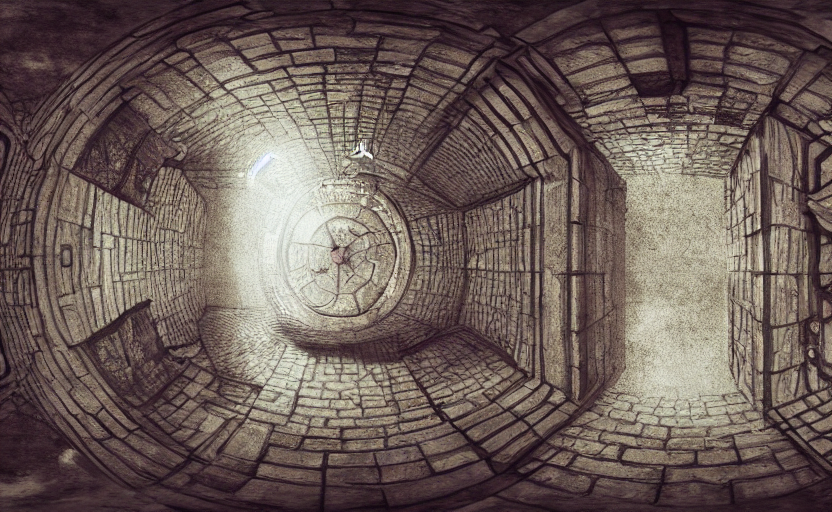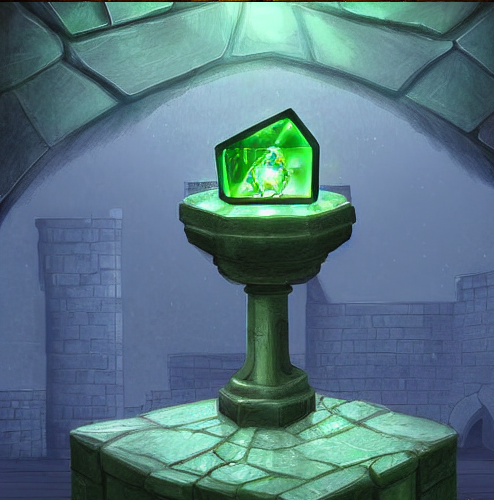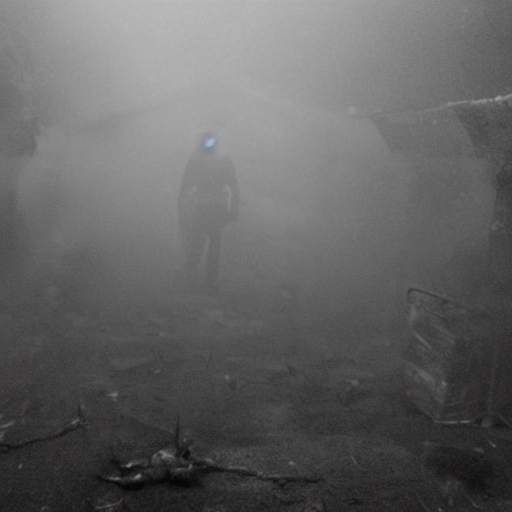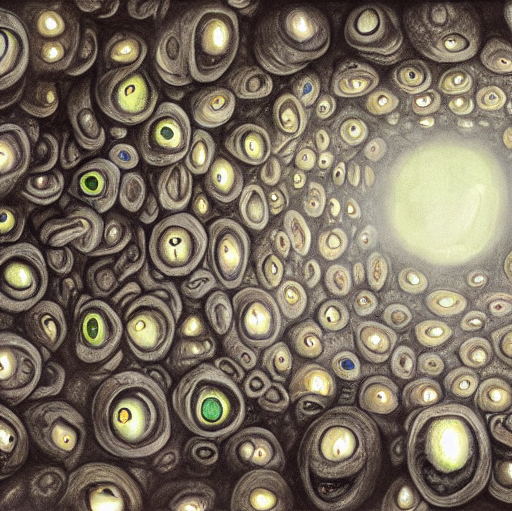Galtor's Keys (4e Encounter)
This is a set of rooms that can be dropped into any dungeon. Three "key" rooms hold strange magical objects. Three "gate" rooms have unusual wall decorations and passages that seal instantly on approach. Each key matches one gate room. They can be encountered linearly or in a branching dungeon.
The items and skill checks are set for a level 6 party.
Key Room 1: Perspective[edit]
This is a perfectly cuboid room, 30' to a side, with smooth white marble walls, ceiling and floor. The entrance is at one corner at a 45 degree angle. As the party enters, they will be facing towards the centre of the room and the far corner. The room is unfurnished with no apparent features. A DC 23 Arcana check reveals the presence of illusion magic.
At the entrance, the room does not appear to be square. The far corner seems to taper to a point in the far distance. As characters move through the room, perspective shifts so that the opposite side of the room always seems to be hundreds of feet away. If a character stands in the exact centre of the room, it can be seen correctly as a perfect cuboid. A character at this point will hear a harmonic tone increasing in volume. After a few seconds, the key object will appear in the exact centre of the floor.
The key object is a glass cube, 8 inches to a side. A smaller cube is inset within, of which the apparent size shrinks and grows depending on the viewers distance from the object. See Perspective Cube (4e Equipment).
Upon initially seeing the warped shape of the room, the party may believe this to be a sort of "black hole" hazard. One clue that this is not the case is the radius of the light shed by the party's light sources.
Combat encounters placed in this room should include artillery monsters: ranged attacks will be subject to the cube's distorting effect.
Key Room 2: Silence[edit]
This is a square room, 20' to a side, of the same construction as the rest of the dungeon. At the far side is a hewn stone pedestal on which rests a green jewel. The jewel is an emerald-cut emerald, and a DC 23 Arcana check reveals the presence of illusion magic. It emits a zone of silence: characters within 20' of it will be unable to hear anything nor create any sound. See Jewel of Silence (4e Equipment).
Combat encounters placed in this room should include a lurker or two. They will benefit from the jewel's +2 bonus to Stealth. Players could be forced to relay tactics via hand gestures, unless they have telepathy.
Key Room 3: Darkness[edit]
This is a chamber of indeterminate size consumed by magical darkness. A DC 23 Arcana check reveals the presence of illusion magic. No light, magical or otherwise, can extend beyond 1 square. Creatures with low-light can see 2 squares with a light source. Creatures with darkvision can see 2 squares. The wall nearest to the entrance is cold, roughly-hewn stone. Following it is futile, it stretches indefinitely. Similarly the far boundry of the room cannot be located. Methodically searching the area near the entrance will reveal a human skeleton, bones slightly scattered, the remains of clothing that crumbles to dust. Around one finger, a silver ring inset with a black opal.
Claiming the ring will banish the darkness, and the party's light sources will show the room to be a mere 30'-wide half-octogon shape. Those that had wandered off far into the darkness find themselves close to the far walls (or in other parts of the dungeon at the DMs discretion). The item is a Ring of Darkness (4e Equipment).
As the limited sight discourages combat movement, a combat encounter should include fantastic terrain that forces movement; one or two creatures with blindsight; and traps taking up the remainder of the XP budget.
Gate Room 1: Eyes[edit]
This chamber has an open passageway that leads further into the dungeon. The wall opposite is covered with 128 inset glass marbles, painted to look like eyes. Some are small, the size of a fingernail. Several are as large as a watermelon. They rotate to stare at the party with a grinding sound. If the party are scattered throughout the room, a DC 15 Perception check will reveal that the eyes focus on the character closest the the passageway. Approaching within 4 squares of the passageway causes an iron slab to rise with great speed to block it. The iron slab is also electrified, touching it causes 5 lightning damage. The link between the eyes and the slab is magical; the eyes have Blindsight and can see through magical darkness.
The intended solution is for the Cube of Perspective to be placed in the centre of the room. This will cause characters near the passageway to appear too far away for the eyes to focus on, so the slab will not rise.
The party may also try these methods:
- Run! A character will need a speed of 10 or higher to cleanly pass the slab before it rises. A speed of 6 or less just won't cut it. A speed of 7-9 requires a DC 23 Athletics check to leap over the slap. On a fail, the slab makes an attack roll of +9 vs. Reflex. On a hit, the character is crushed for 2d10 damage, restrained and takes ongoing 5 lightning damage (save ends both, or until the slab is lowered by some other means).
- Lowering the slab - The mechanism is completely sealed, but a lenient DM might allow a DC 23 Perception and Thievery check to uncover this. Accessing the mechanism necessarily means being near the slab, so it will be raised. A further two Thievery checks will lower the slab. The player attempting this should be made aware that failing either of these rolls by 5 or more will permanently jam the slab in the raised position. A Thievery check can also be made on the mechanism to turn off the electricity.
- Cover the eyes - Covering the whole 200 square feet of wall with a perfectly opaque material will foil this gate. So will obscuring each and every eye with thick, opaque paint: tar would work; ink would be time-consuming, needing several layers, one vial per eye. This would take a party of five 15 to 30 minutes depending on their ability to reach the eyes near the ceiling.
- Break the eyes - Smashing one eye requires an impaling tool or weapon, succeeding on a Strength check, DC 15. Breaking an eye releases a burst of electricity causing 5 lightning damage in close burst 2. Breaking the eyes near the ceiling without a stable platform is harder (DC 23), and attacking at range (with bolts, arrows, dagger) adds 2 to the DC. If the party wishes to undertake this method for the whole wall, it requires 10 to 20 minutes. It requires four Strength checks (two for the lower set of eyes, two for the higher set of eyes). Arcana can be substituted if an appropriate spell is used. A character making a check loses 1 healing surge if they are not smashing the eyes at range, and they do not have lightning resistance.
Gate Room 2: Ears[edit]
This chamber is similar to Gate Room 1, but the wall is covered with a variety of carved ears: human and animal, large and small, constructed from marble, iron, or stone.
The gate works in the same way, raising an electrified metal slab to seal the passageway if any of the magical ears hear anything near it. The intended solution is to place the jewel of silence in the room. In addition to the above options of running, breaking the sensors, or lowering the slab, the party may also:
- Sneak - each character attempting to pass through gate silently must make a DC 23 Stealth check.
- Plug the ears - Using a waxy substance. The timescale and material requirements is similar to "covering the eyes", above.
Gate Room 3: Light[edit]
This chamber features four columns of glass, at the centre of each is an intense phosphorous fire. The columns integrate prisms and mirrors that focus the torchlight into beams that touch sensors embedded behind glass in the ceiling and walls. The beams are hot, and a creature starting their turn in the path of one takes 15 fire damage.
As with room 1 and 2, the exit is an electrified metal slab that rises quickly when a creature approaches it. The intended solution is to drop the ring of darkness found in Key Room 3, preventing the light reaching the sensors and allowing creatures to pass through the gate. On the first turn of darkness, the sounds of machinery can be heard under the floor. On the second turn of darkness, the slab lowers.
The above options of running, or lowering the slab are possible. In addition:
- Block the light - Powers or items that create darkness will deactivate the gate. Either one power that covers 5 x 5 squares, or three that cover 3 x 3 squares would be sufficient, and those powers need to be sustained for two turns. The players can try and paint over, or cover the sensors or pillars, but the light beams will burn through most substances.
- Breaking the glass - to get to the everburning torches requires significant time (the glass is magically toughened) and creates significant noise that would attract wandering monsters. Use the "break the eyes" method from Gate Room 1, above.
Rewards[edit]
Each key is guarded by an encounter, typically a trap or skill challenge with a scattering of monsters. This will have its own XP reward along with the magical item used as the key.
If a key is missed, the players may have gotten through the gate by one of the alternate methods. A successful method with at least four skill checks or ability checks can be given an XP award appropriate for a complexity one skill challenge. A more brute-force method that attracts wandering monsters grants XP from that combat encounter.
You may allow the players to backtrack and take the key items at your discretion. If you do so, those items can be considered to be treasure parcels.
Back to Main Page → 4e Homebrew



